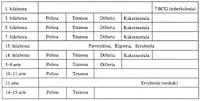Infectious and contagious diseases
As the name itself indicates, these diseases, many very different from each other, have at least two common characteristics:
- Infectious, that is, agents or living creators.
- Contaminants, that is, they can be spread from one patient to another. * The agents or living creators are very varied: VIRUS (very small). They can be seen using an electronic microscope. For some are among living and inanimate beings. They must necessarily live within a cell. BACTERIA (older). They are seen in the normal microscope. FUNGI. They produce mycosis. PROTOZOOS, unicellular beings. Malaria, amebiasis, toxoplasmosis, etc. produce. WORMS. Parasites of the digestive system, e.g.
- ARTHROPODS: Fleas, etc. * The transmission, that is, the transfer of the disease from one person to another, can occur in two main ways:
- In a DIRECT way: without intermediaries.
- NOT DIRECT: by means (injection, clothing or towel, food, dishes, etc.)
Let's look at the main pollution routes:
- The droplets that the sick person pulls when speaking or coughing, are ingested by another person when breathing and contaminated. Medium of ironing. Eat contaminated food or drinks or carry contaminated hands or objects to your mouth. By blood: Bites of contaminated animals (rabies), insect bites. By injections, if the syringe or liquid are contaminated. Blood transfusions.
- From the skin: a small wound that is then malignant...
Stages of infectious and contagious diseases
- INCUBATION. From the introduction of germs to the onset of symptoms. MANIFEST DISEASE. Symptoms. It can happen that a disease passes without symptoms, but that person is carrier (carries the germ inside) and is able to infect others.
- RECOVERY. Recovery after the disappearance of symptoms.
Contamination of these diseases
Each case is different.
Normally, contamination begins in the incubation period and ends in recovery, but there are diseases that remain in a carrier state for a long time (even after clinically cured), such as the type of hepatitis itself.
Immunity and immunity
It is the defensive system that the body mounts and prepares against these germs (or external attacks).
This defensive system is mainly based on antibodies and lymphocytes, and in certain areas of the body (iz-tondoan, besapea, throat tonsils) we have certain defensive barriers or barriers to perform the first defense.
When a given germ comes into contact for the first time with the body (although no disease occurs later), the body has somehow "known" that germ and has prepared some defenses for a next visit that will allow it to deal with. In some cases (although not always) they will be able to avoid infections or infections. This is the essence of immunity.
With friends, for example
- The fetus already has tonsils in the 3rd month. Tonsils grow from the 4th month until birth. They continue to grow until the 6th month after birth and then a kind of STABILIZATION arrives. Around year 2 the tonsils grow a lot and this coincides with the incorporation of the child to school or nursery (attack of new germs).
- This seed is kept until puberty, then go slightly down.
This immunity or defense is sometimes eternal (that is, after passing some diseases do not happen again: measles for example), but in other cases it disappears after time. Each disease has its fixed period of immunity, marked by the characteristics of its germ.
The immunity can be:
- Natural, that is, derived from the healing and overcoming of the disease.
- Artificial or externally implanted: immunoglobulins and especially vaccines. See below the vaccination plan or schedule.
Treatment of infectious and contagious diseases
These diseases are very varied.
Some are light, with few symptoms and low severity. With them it is possible to relax.
Others, however, are more etched, give stronger and acute symptoms, in which treatment should be more intense.
In general, medicine should not be abused. These symptoms, on the other hand, are beneficial to the body when they are not intense, since they represent a certain defensive reaction.
- REST. As complete as possible, of all the functions and apparatus of the body, especially of the digestive system. SYMPTOMS medicines (fever, pain,...) GERM drugs (antibiotics, sulfami-ds, ...
Infectious diseases at school
These diseases have been called “childhood diseases” and not for lack of reason. In fact, it is in childhood when more occur. And why?
- Because the immunity of the child is insufficient. The body of the young child has not yet had time to contact the germines and create defense against them.
- Close relationships with other children arise in school. The first year of schooling is very good for many contaminants to occur. The child goes from a closed and familiar environment (the house, family) to another wider and unknown (school, lots of children)
Measures to be taken at school
First, it is advisable to put in place the problem of infecto-contagious diseases, before committing any abuse.
In childhood, some of these diseases are not serious (they are much more serious in the adult). Therefore, it is convenient for the child to suffer these mild diseases in the best conditions to be immunized.
- Minimum hygienic conditions, school Cleaning, disinfection. Sanitary control of school staff: respiratory and food manipulator. Patient isolation It will always depend on the disease. The patient should not go to school (both students and teachers). The duration of the insulation varies according to the case. Surveillance or observation of carriers. Depending on the disease (lice, tuberculosis, etc.) The source of the disease will be sought and special measures will be taken. Disseminate adequate information to both parents (so that the contamination chain is not excessively extended) and to the Authorities or Health Entities.
Buletina
Bidali zure helbide elektronikoa eta jaso asteroko buletina zure sarrera-ontzian












